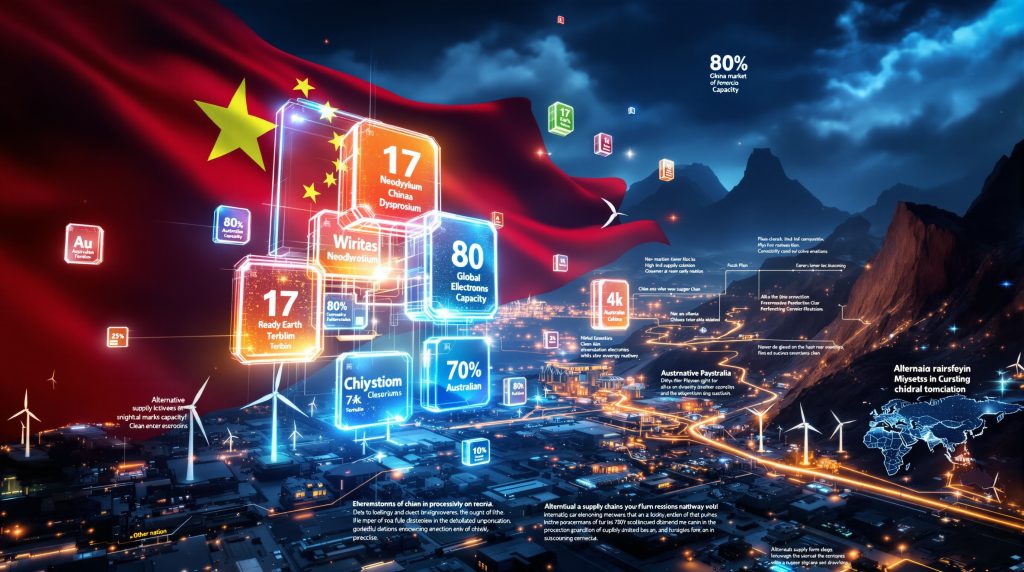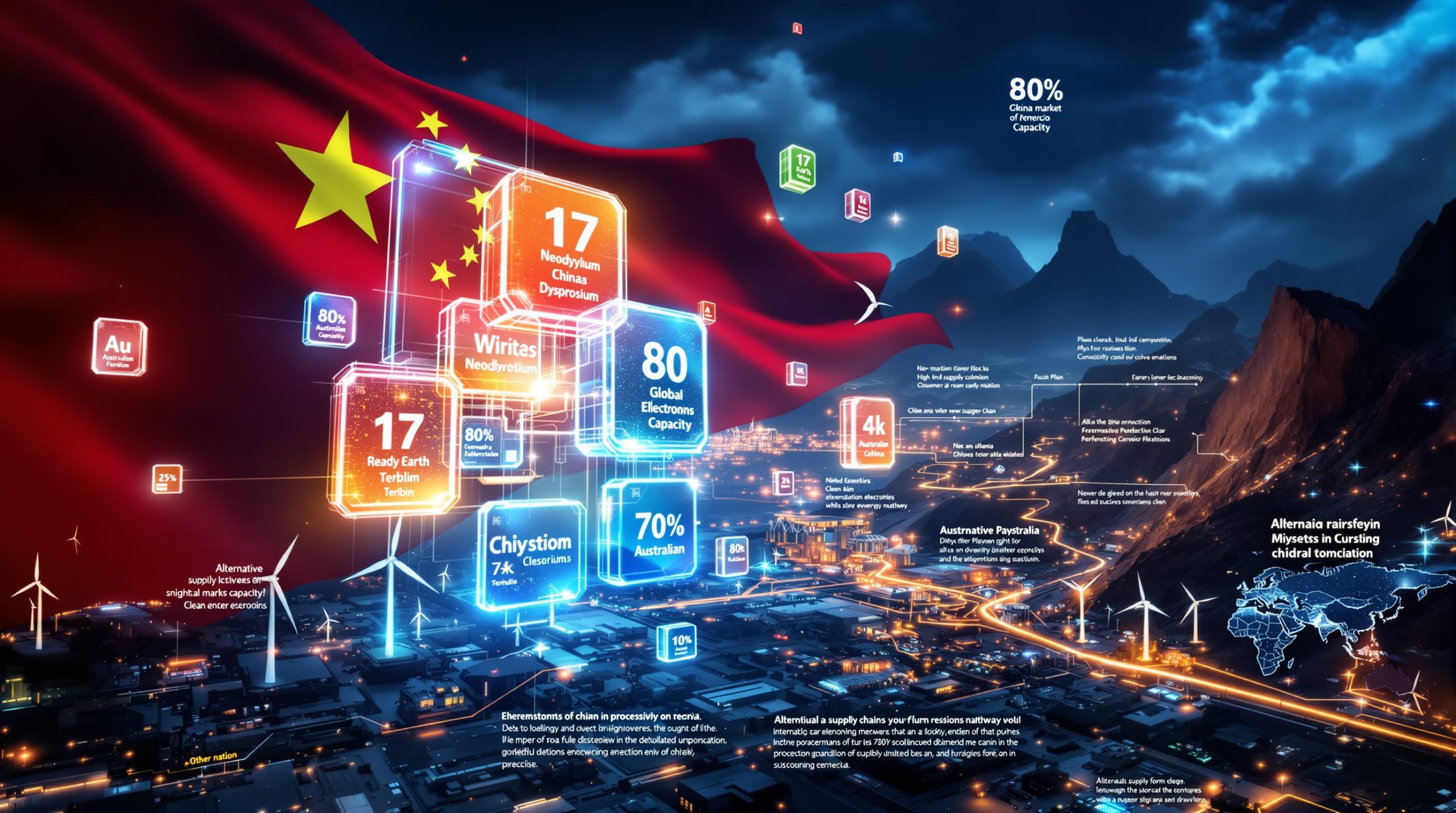China's Rare Earth Export Controls: Global Supply Chain Implications
The global technology and manufacturing sectors are facing significant disruption as China implements new restrictions on rare earth technology exports. These strategic materials, essential for everything from smartphones to electric vehicles, have become a focal point of international trade tensions. With China controlling a substantial portion of the global rare earth supply chain, these new export controls have far-reaching implications for industries worldwide.
What Are Rare Earth Elements and Why Do They Matter?
Rare earth elements (REEs) comprise 17 metallic elements essential for modern technology manufacturing. Despite their name, most are relatively abundant in the Earth's crust but rarely found in concentrated, economically viable deposits.
According to the United States Geological Survey's 2024 assessment, global rare earth reserves total approximately 110 million tonnes. China holds the largest share with 44 million tonnes, followed by Brazil (22 million), Vietnam (21 million), Russia (10 million), India (7 million), and Australia (4.2 million).
Key Rare Earth Elements and Their Applications
These specialized materials serve critical functions across various industrial sectors:
Light rare earths include neodymium, praseodymium, cerium, and lanthanum. They're vital components in:
- Permanent magnets for electric motors and generators
- Catalytic converters for vehicle emissions reduction
- Glass polishing compounds and precision optics
- Battery electrodes and hydrogen storage materials
Medium and heavy rare earths such as dysprosium, terbium, samarium, and gadolinium provide essential properties for:
- High-temperature resistant magnets in harsh environments
- Advanced defense systems and guidance technology
- Medical equipment including MRI contrast agents
- Specialized laser and lighting applications
Industries Dependent on Rare Earth Materials
The strategic importance of these elements extends across numerous high-tech sectors:
Clean energy technology relies on rare earths for:
- Wind turbine generators (each requiring up to 600kg of rare earth materials)
- Electric vehicle motors and battery systems
- Solar panel components and energy storage systems
Consumer electronics utilize rare earths in:
- Smartphone vibration motors and speakers
- Computer hard drives and display technologies
- Audio equipment and wireless charging systems
Defense systems depend on rare earths for:
- Precision-guided munitions and navigation systems
- Radar and sonar equipment
- Night vision technology and communications systems
Medical technology applications include:
- MRI machines and diagnostic equipment
- Surgical tools requiring precise motorization
- Radiation therapy and imaging technologies
Automotive applications extend beyond electric vehicles to:
- Catalytic converters in conventional vehicles
- Sensors and control systems
- Battery technology and hybrid propulsion systems
How Has China Dominated the Global Rare Earth Market?
China's strategic development of its rare earth industry represents one of the most successful examples of resource-based economic planning in recent decades.
China's Strategic Development of Rare Earth Production
China systematically built its rare earth dominance through a multi-faceted approach:
Early investment in the sector began when most Western nations overlooked these materials:
- Recognizing strategic value decades before competitors
- Developing technical expertise while other countries focused elsewhere
- Building comprehensive research and development programs
Vertical integration created a complete supply chain under Chinese control:
- Mining operations spanning multiple provinces
- Processing facilities with specialized capabilities
- Manufacturing capacity for value-added products
- Research institutions developing proprietary technologies
Environmental regulation advantages reduced production costs significantly:
- Less stringent oversight of mining industry innovation
- Fewer requirements for waste management
- Limited pollution controls compared to Western producers
- Lower operational costs attracting international business
State support ensured the industry's development through:
- Government subsidies and preferential policies
- Extensive research funding for technological advancement
- Strategic export and import controls
- Integration into national economic plans
Current Market Control Statistics
China's dominance extends across the entire rare earth supply chain:
| Aspect of Rare Earth Supply Chain | China's Global Share |
|---|---|
| Mining production | >60% |
| Processing capacity | >80% |
| Magnet manufacturing | ~90% |
| Patent ownership | Dominant position |
As noted by ABC News in October 2025, "China has filed a huge number of patents on rare earth production, an obstacle to companies elsewhere hoping to launch large-scale processing." These patents create significant barriers for new entrants attempting to develop alternative supply chains.
Historical Context of China's Export Policies
China's approach to rare earth exports has evolved significantly:
2010-2014: Initial export quotas and restrictions
- Implementation of formal export quotas
- Restricted shipments to Japan during diplomatic tensions
- World Trade Organization challenges by Western nations
- Rising global awareness of supply vulnerabilities
2015-2020: WTO challenges and policy adjustments
- China reformed export policies following WTO rulings
- Introduced resource taxes and environmental requirements
- Consolidated industry through mergers and acquisitions
- Increased focus on domestic value-added manufacturing
2021-2024: Integration of rare earths into strategic frameworks
- Rare earths designated as strategic resources
- Enhanced environmental regulation of domestic production
- Introduction of initial licensing requirements
- Development of comprehensive export control systems
2025: New comprehensive export control regime
- April 2025: Implementation of export licenses for certain rare earth products
- October 2025: Expansion of controls to technologies for mining, processing, and manufacturing
What New Export Controls Has China Implemented?
China's recent policy changes represent a significant escalation in its strategic management of rare earth resources and technologies.
Licensing Requirements and Scope
According to the Chinese commerce ministry statement from October 9, 2025, the new export controls include:
- Mandatory export licenses for rare earth technologies and materials
- Controls on mining, smelting, and processing technologies
- Restrictions on equipment for production line assembly, maintenance, and repair
- Special scrutiny for exports with potential military applications
These measures significantly expand the April 2025 licensing requirements, creating a comprehensive system of oversight for the entire rare earth supply chain originating from China.
Extraterritorial Reach of New Regulations
The new controls extend beyond China's borders through several mechanisms:
- Applying to foreign-made products containing Chinese rare earths
- Requiring permits for re-export of Chinese-origin materials
- Explicitly prohibiting approvals for military end-users
- Creating compliance obligations for non-Chinese companies
This extraterritorial approach means that companies operating outside China but utilizing Chinese rare earth materials or technologies will face permit requirements before making certain shipments. As stated by the Chinese commerce ministry, these restrictions specifically target foreign entities that export related items outside of China.
Stated Rationales for the Export Restrictions
Chinese authorities have cited several justifications for the new controls:
- Preventing unauthorized transfers to military operations
- Protecting national security interests
- Addressing environmental concerns
- Conserving strategic resources
A Chinese ministry spokesperson specifically noted that "some overseas organisations and individuals have directly or after processing transferred or provided controlled rare-earth items originating in China… for direct or indirect use in sensitive areas such as military operations." The spokesperson claimed this caused "significant damage or potential threats to China's national security and interests" and "adversely impacted international peace and stability."
How Are Global Industries Being Affected?
The implementation of China's rare earth export controls has created ripple effects throughout global supply chains.
Immediate Supply Chain Disruptions
According to ABC News reporting from October 2025, "The restrictions imposed by Beijing this year have caused significant disruption in worldwide industries, with some companies facing halts to production as supply of the key minerals dwindles."
These disruptions manifest in several ways:
Production delays are occurring as manufacturers struggle to:
- Secure necessary permits for material shipments
- Navigate complex compliance requirements
- Find alternative suppliers for critical components
- Adjust manufacturing processes to accommodate material changes
Inventory challenges are becoming increasingly common:
- Companies struggling to maintain sufficient material stockpiles
- Just-in-time manufacturing systems breaking down
- Longer lead times required for production planning
- Strategic reserves being utilized more rapidly than anticipated
Price volatility has intensified across rare earth markets:
- Spot prices experiencing significant upward pressure
- Long-term contract negotiations becoming more difficult
- Cost pass-through creating challenges for manufacturers
- Margin compression for products with fixed pricing structures
Contract uncertainties have emerged regarding:
- Delivery timeframes becoming less predictable
- Force majeure clauses being invoked by suppliers
- Renegotiation of terms becoming necessary
- Legal complications around compliance requirements
Sector-Specific Impacts
The effects of China limits rare earth exports vary significantly across industries:
Automotive Industry
Electric vehicle manufacturers face particularly acute challenges:
- Component shortages affecting production targets
- Magnet suppliers struggling to meet contracted volumes
- Price increases for specialized rare earth components
- Potential redesigns to reduce rare earth dependence
This sector's vulnerability stems from its heavy reliance on neodymium, praseodymium, and dysprosium for high-performance permanent magnets used in electric motors.
Electronics Manufacturing
Consumer electronics producers are experiencing:
- Extended lead times for critical components
- Rising costs affecting competitive pricing
- Supply allocation becoming more selective
- Accelerated research into alternative materials
The electronics sector's extensive use of rare earth elements in speakers, vibration motors, and display technologies makes it particularly sensitive to supply disruptions.
Defense and Aerospace
Military and aerospace manufacturers face strategic concerns about:
- Access to materials for advanced weapons systems
- Potential delays in defense procurement programs
- Supply chain vulnerabilities affecting national security
- Reassessment of material stockpiling requirements
The defense sector's reliance on high-performance rare earth materials for precision guidance systems, radar technologies, and communications equipment creates particular sensitivity to export restrictions targeting military end-users.
What Are the Geopolitical Implications of China's Rare Earth Strategy?
China's control over rare earth supply chains provides significant leverage in international relations and trade negotiations.
Trade Tensions and Diplomatic Responses
The new export controls have prompted immediate diplomatic reactions:
EU concerns have been explicitly stated, with:
- European Commission expressing "concern" over China's announcement
- EU trade spokesman Olof Gill stating on October 9, 2025: "The commission expects China to act as a reliable partner and to ensure stable, predictable access to critical raw materials"
- Questions arising about implementation of agreements reached during July 2025 meetings between European Union chief Ursula von der Leyen and Chinese leaders
- A European business lobby warning about ongoing challenges in securing access to materials
US reactions have highlighted:
- Tensions regarding rare earth access in trade negotiations
- Accusations that China is "slow-walking export licence approvals"
- Concerns about impacts on manufacturing sectors
- Potential for escalation in broader US‑China trade war strategies
WTO considerations involve complex questions about:
- Compatibility of China's export controls with trade obligations
- Potential grounds for formal challenges
- Precedents from previous rare earth export cases
- Resolution mechanisms for trade disputes
Bilateral negotiations are underway focusing on:
- Efforts to secure exemptions or special arrangements
- Clarification of implementation procedures
- Establishment of predictable application processes
- Resolution of specific compliance challenges
Strategic Leverage in International Relations
China's rare earth export controls provide leverage in multiple domains:
- Trade negotiations with major economies
- Technology transfer discussions
- Geopolitical positioning in the Asia-Pacific region
- Response to sanctions or restrictions on Chinese companies
This strategic resource position enables China to exert influence disproportionate to the relatively small market value of rare earth materials themselves, leveraging their critical importance to high-technology manufacturing and defense applications.
How Are Countries Responding to Reduce Dependence?
Nations and industrial blocs are pursuing multiple strategies to address rare earth supply vulnerabilities.
Alternative Supply Chain Development
Efforts to diversify supply sources include:
Mining projects outside China are being accelerated:
- Existing operations expanding production capacity
- New deposits being explored and developed
- Investment flowing to previously marginal projects
- Expedited permitting processes in some jurisdictions
Processing investments are developing new capabilities:
- Facilities in Australia, the United States, and Europe
- Joint ventures between mining companies and end-users
- Technology transfer agreements with established processors
- Government support for strategic processing capabilities
Recycling initiatives are gaining momentum:
- Enhanced recovery from electronic waste
- Development of specialized recycling technologies
- Implementation of collection systems for end-of-life products
- Research into more efficient extraction methods
Stockpiling programs are being established:
- Strategic reserves at national and regional levels
- Corporate inventory management practices evolving
- Cooperative industry approaches to material security
- Buffer stocks to manage short-term disruptions
Country-Specific Strategies
Major economies are pursuing tailored approaches to rare earth supply security:
United States
The U.S. response includes multiple policy mechanisms:
- Defense Production Act authorizations for rare earth projects
- Tax incentives for domestic production and processing
- Research funding for alternative materials and technologies
- Strategic partnerships with allied nations including Australia
According to Reuters reporting from October 2025, "The European Union and the United States are both trying to boost their own production of rare earths and better recycle what they use to reduce dependence on Beijing."
In response to China's growing control of the market, Trump's critical minerals order has further prioritized domestic production capabilities.
European Union
The EU has developed a comprehensive approach including:
- Critical Raw Materials Act implementation
- Circular economy initiatives for rare earth recycling
- Diplomatic efforts to secure supply agreements
- Research funding for substitution technologies
European Commission efforts have focused on ensuring "stable, predictable access to critical raw materials" according to EU trade spokesman Olof Gill in October 2025.
Australia
Australia is leveraging its significant resource position through:
- Expansion of existing mining operations
- Development of domestic processing capabilities
- Strategic partnerships with end-users
- Government support for Australia green metals leadership
What Role Can Australia Play in the Global Rare Earth Supply Chain?
Australia represents one of the most promising alternatives to Chinese rare earth dominance.
Australia's Rare Earth Resources and Potential
Australia possesses significant rare earth deposits, estimated at 4.2 million tonnes according to the USGS data. This positions the country as a potentially vital alternative supplier in the global market.
Australia's geological advantages include:
- Diverse deposit types across multiple regions
- Favourable mining jurisdictions with established regulations
- High-quality resources with economically viable grades
- Potential for both light and heavy rare earth production
Current and Planned Production Facilities
Australia's rare earth sector is developing rapidly:
Existing operations include several active mines with expansion potential:
- Multiple projects in Western Australia and Northern Territory
- Established export relationships with international partners
- Growing production volumes entering global supply chains
- Increasing investment in capacity expansion
Processing developments are addressing critical supply chain gaps:
- New separation facilities under construction
- Capabilities expanding beyond concentrated mineral production
- Value-added processing creating higher-value exports
- Technical expertise developing in specialized processing
Integration opportunities are emerging through:
- Partnerships with manufacturing sectors
- Research collaboration with end-users
- Technology transfer agreements
- Co-investment in specialized facilities
Export capacity is growing to meet international demand:
- Increasing ability to supply diverse international markets
- Quality standards meeting manufacturer requirements
- Logistics systems supporting reliable delivery
- Trade relationships diversifying beyond traditional partners
Challenges for Australian Industry Development
Despite its potential, Australia's rare earth industry faces several challenges:
Capital requirements present obstacles including:
- High investment needs for processing facilities
- Extended payback periods for complex projects
- Financing complexities for specialized technologies
- Competition for capital with other resource sectors
Technical expertise limitations include:
- Building specialized workforce capabilities
- Acquiring proprietary processing knowledge
- Developing research and development infrastructure
- Competing with established technical centers
Environmental regulations create compliance requirements:
- Meeting stringent standards for waste management
- Water management in arid mining regions
- Radioactive element management in some deposits
- Community expectations for sustainable operations
Market competition presents ongoing challenges:
- Competing with established Chinese producers
- Price sensitivity in international markets
- Scale disadvantages compared to larger operations
- Integration into existing supply chains
Can Technological Innovation Reduce Rare Earth Dependence?
Research and development efforts are focusing on technological solutions to rare earth supply vulnerabilities.
Alternative Materials Research
Scientists and engineers are pursuing multiple avenues to reduce rare earth dependence:
Magnet technologies under development include:
- Reduced-rare-earth magnets requiring smaller amounts of critical elements
- Rare-earth-free alternatives using different magnetic principles
- Nanostructured materials with enhanced performance characteristics
- Hybrid designs combining multiple magnetic materials
Substitution approaches are exploring:
- Alternative elements for similar functionality
- Composite materials with comparable properties
- Novel alloys with reduced critical material content
- Engineered materials with specialized microstructures
Design innovations are creating system-level solutions:
- Engineering approaches requiring fewer critical materials
- Alternative motor designs using different principles
- Architectural changes to minimize material requirements
- Performance optimization through computational modeling
Efficiency improvements are focusing on:
- Reducing material requirements through optimization
- Enhancing performance of existing material compositions
- Minimizing waste in manufacturing processes
- Extending component lifespans through improved designs
Recycling and Urban Mining Developments
Recovering rare earths from existing products represents a growing opportunity:
Recovery technologies are advancing through:
- Advanced methods for extracting rare earths from waste
- Chemical processes optimized for specific material streams
- Automated disassembly systems for complex products
- Energy-efficient separation techniques
Collection systems are evolving to support:
- Improved gathering of end-of-life products
- Specialized handling for rare earth-containing components
- Tracking systems for material accountability
- Incentive programs for consumer participation
Economic incentives are being developed to:
- Make recycling financially viable at commercial scale
- Encourage design for recyclability
- Support infrastructure development
- Create market pull for recycled materials
Circular economy models are emerging based on:
- Designing products for material recovery
- Service-based approaches maintaining manufacturer ownership
- Material passports tracking critical elements
- Closed-loop systems within industrial sectors
What Should Businesses Do to Manage Rare Earth Supply Risks?
Companies dependent on rare earth materials can implement multiple strategies to enhance supply security.
Supply Chain Risk Assessment Strategies
Proactive risk management approaches include:
Vulnerability mapping to identify:
- Critical dependencies throughout supply networks
- Single-source components requiring special attention
- Geographic concentrations creating risk exposure
- Regulatory compliance requirements affecting material flows
Supplier diversification strategies focusing on:
- Developing multiple sourcing options where possible
- Qualifying alternative suppliers before disruptions occur
- Building relationships with emerging producers
- Creating flexibility in material specifications
Inventory management approaches including:
- Strategic stockpiling of critical materials
- Buffer stocks at key supply chain nodes
- Safety margin calculations incorporating geopolitical risk
- Dynamic adjustment based on market conditions
Contract strategies designed to:
- Secure long-term supply agreements
- Include flexibility provisions for volatile markets
- Address regulatory compliance responsibilities
- Manage price risk through appropriate mechanisms
Long-Term Adaptation Approaches
Sustainable solutions to rare earth supply challenges require fundamental business adaptations:
Product redesign initiatives focusing on:
- Reducing dependence on restricted materials
- Modular approaches allowing component substitution
- Design for recycling and material recovery
- Performance optimization with alternative technologies
Material substitution strategies including:
- Finding alternatives for vulnerable components
- Qualifying substitute materials before crises occur
- Developing specifications accommodating material variation
- Research partnerships exploring novel solutions
Vertical integration opportunities to:
- Secure upstream supply chain control
- Invest directly in material production
- Participate in recycling infrastructure development
- Build technical expertise in critical materials
Geographic diversification approaches spreading:
- Operations across multiple regions
- Supply chain nodes to reduce vulnerability
- Technical capabilities beyond traditional centers
- Risk exposure across diverse regulatory environments
What Does the Future Hold for Rare Earth Supply Chains?
The rare earth market is likely to experience significant transformation over the coming years.
Projected Market Developments
Several trends are likely to shape market evolution:
Price trends will likely show:
- Continued volatility with upward pressure
- Premium pricing for reliable, compliant supply
- Regional price differentials based on regulatory environments
- Separation between pricing for different rare earth elements
Supply diversification will gradually emerge through:
- New producers entering the market
- Expanded recycling capacity
- Development of alternative technologies
- Evolution of production methods
Processing capacity will develop with:
- Expansion outside China, but with significant time lags
- Regional hubs developing in strategic locations
- Technical capabilities spreading to new centers
- Specialized facilities for specific material streams
Demand growth will be driven by:
- Increasing requirements from critical minerals energy transition
- Expansion of electric vehicle production
- Advanced electronics manufacturing
- Defense technology requirements
Critical Uncertainties and Scenarios
Several factors will determine how the rare earth market evolves:
Policy evolution questions include:
- How Chinese export controls might change over time
- Western government support for alternative supply chains
- Environmental regulation of mining and processing
- Trade policy developments affecting material flows
Technology breakthroughs could emerge in:
- Alternative materials with superior performance
- Novel extraction and processing methods
- Recycling technologies enabling circular economy
- Design approaches reducing material requirements
Geopolitical developments that could influence the market include:
- Broader US-China relations and trade policy
- Regional security arrangements affecting supply chains
- Resource nationalism trends in producing countries
- International cooperation on critical materials
Environmental factors that may shape the industry include:
- Sustainability pressures on mining and processing
- Carbon footprint considerations for material production
- Water management requirements in arid regions
- Community acceptance of new projects
FAQs About Rare Earth Export Restrictions
What exactly are rare earth elements?
Rare earth elements are a group of 17 metallic elements including the 15 lanthanides plus scandium and yttrium. Despite their name, most are relatively abundant in the Earth's crust but rarely concentrated enough for economical extraction. They possess unique magnetic, luminescent, and electrochemical properties that make them essential for high-technology applications ranging from smartphones to electric vehicles and defense systems.
Why can't other countries simply increase their production?
Developing rare earth mining and processing capabilities requires significant investment, specialized expertise, environmental permitting, and time. The complex processing technologies have been perfected in China over decades and cannot be replicated quickly. As noted in ABC News reporting, "China has filed a huge number of patents on rare earth production, an obstacle to companies elsewhere hoping to launch large-scale processing." Additionally, environmental regulations in many countries impose higher compliance costs than those faced by Chinese producers historically.
Are there viable alternatives to rare earth elements?
For some applications, alternatives exist but often with performance trade-offs. Complete substitution is currently impossible for many high-performance applications, particularly in permanent magnets used in electric vehicles and wind turbines. Research into alternative materials is progressing, but commercial-scale implementation typically requires years of development and qualification. System redesigns that eliminate the need for rare earths often involve fundamental technology changes rather than simple material substitution.
How long might supply disruptions last?
Supply chain adjustments will likely take 3-5 years minimum, with full diversification potentially requiring a decade or more, especially for heavy rare earths where China's dominance is most complete. The development timeline includes exploration, resource verification, permitting, construction of mining operations, development of processing capabilities, and qualification of materials with end-users. Recycling capacity development faces similar timeframes for reaching commercial scale.
What industries face the greatest risk from these restrictions?
Defense, electric vehicles, wind energy, and advanced electronics face the most significant vulnerabilities due to their dependence on high-performance rare earth magnets and specialized applications. These sectors often require specific performance characteristics that cannot be easily achieved with alternative materials. Additionally, industries with complex qualification requirements for materials face longer adaptation periods when supply chains are disrupted, as new sources must undergo extensive testing before implementation.
Australia's Potential as an Alternative Rare Earth Supplier
Australia's significant rare earth reserves and established mining industry position it as a promising alternative to Chinese supply dominance. With approximately 4.2 million tonnes of rare earth deposits according to USGS assessments, Australia has the geological potential to become a major player in global supply chains.
The country's established regulatory framework, skilled mining workforce, and history of resource development provide advantages for accelerated industry growth. However, developing processing capabilities beyond mining represents a critical challenge requiring substantial investment and technical expertise.
Strategic partnerships between Australian producers and international technology manufacturers could create mutually beneficial relationships that address supply security concerns while developing domestic value-added processing. Government support for research, development, and infrastructure will likely play an important role in establishing Australia as a reliable alternative in global rare earth supply chains.
Ready to Stay Ahead of Major Mineral Discoveries?
Receive instant alerts about significant ASX mineral discoveries with Discovery Alert's proprietary Discovery IQ model, turning complex mineral data into actionable insights for investors. Understand why historic discoveries can generate substantial returns by visiting Discovery Alert's dedicated discoveries page and begin your 30-day free trial today.




